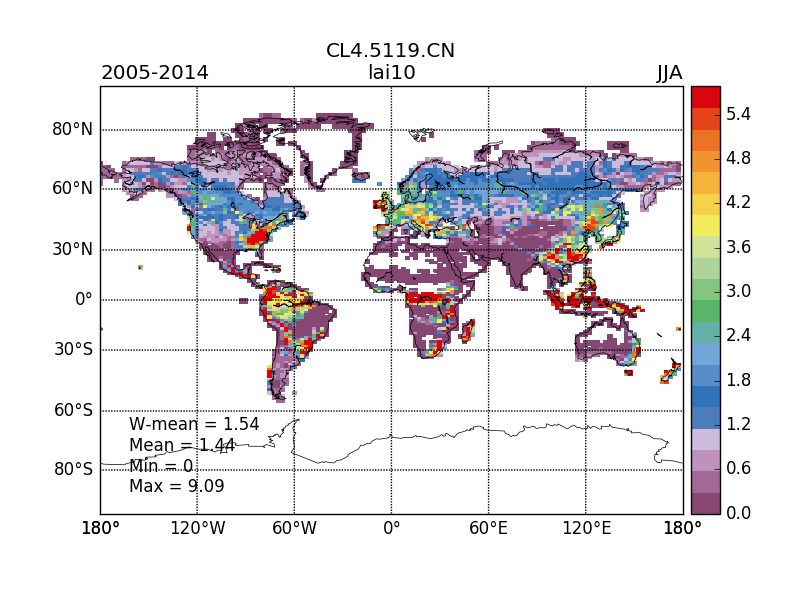| Version 7 (modified by nvuilsce, 6 years ago) (diff) |
|---|
Minutes of the meeting of May 31, 2018
- Presents: Fabienne, Vladislav, Philippe P, Nicolas Viovy, Nicolas Vuichard
- Problem in the phenology:
- Here an illustration of the problem:

- Problem in the way to compute the mean LAI per PFT in the mapper: The new diagnostic developed by Vlad shows the contribution of each PFT to the total LAI for specific regions (latitudinal bands, continents, ...). This is sensitive to the land use map used and is not the diagnostic expected (ie mean LAI for each PFT for a specific region).
Action => Vlad will correct this in order to clearly identify which PFT(s) have a very bad phenology - Fabienne agrees on working on this issue. Nicolas Vui will give her the information needed for running this version of ORCHIDEE (next Thursday morning)
- Several actions related to this problem of phenology
- To modify specific parameters related to the allocation and/or the senescence. Based on the diagnostic, the problem might be only related to the leaf onset, which seems to slow in the temperate areas. Because the leaf onset is not enough abrupt, due to the residence time of the biomass, the problem at the leaf onset may impact as well the senescence phase.
- To ensure that there is no change in the allocation module of the CN-CAN version compared to the CN version
- And/or : To switch on the allocation module of CN and to switch on the one from CN-CAN
- Here an illustration of the problem:
- Set-up of the coupled simulations LMDzOR:
- For the moment, only one LMDzOR simulation has been done, in which the leaf C/N ratio was precribed with default values.
- Simulations with dynamical C/N ratio have to be launched: Vlad will do one soon, starting from scratch. One may also envisage to launch one but starting from a restart file for orchidee component.
- A simulation with C/N fix could also be done but with more realistic C/N ratio (spatialized) than those used in the first simulation.
- Problem in the autotrophic respiration
- The share between maintenance and growth respiration is almost the opposite than the one expected.
- There is an additional source of respiration related to the excess of labile Carbon when this pool reaches too high values. The respiration term is included into the growth respiration. This does not help to tune the maintenance and growth respiration terms.
- Action: to remove the addition respiration related to the labile C and to diagnose the contribution of growth and maintenance respiration to the autotrophic respiration
Minutes of the meeting of June, 7
Presents: Patricia, Sebastiaan, Fabienne, Vladislav, Nicolas Viovy, Philippe P., Nicolas Vuichard
- Problem of phenology of grasslands
- About the differences in the routine dealing with allocation (stomate_growth_fun_all) between the CN version and CN-CAN version, Sebestiaan don’t think there are significant changes. The main difference is a difference in the parametrisation: In CN-CAN, grasslands are evergreen vegetation while they are deciduous in the CN version.
- About the differences in the routine dealing with allocation (stomate_growth_fun_all) between the CN version and CN-CAN version, Sebestiaan don’t think there are significant changes. The main difference is a difference in the parametrisation: In CN-CAN, grasslands are evergreen vegetation while they are deciduous in the CN version.
=> one test simulation could be launched in force mode, setting the grasslands as evergreen
- The new diagnostic for looking at seasonal variation of LAI per PFT over specific regions developed by Vlad is not ready yet.
- Instead, we looked at the LAI maps generated per season (DJF,MAM,JJA,...) which are available on the mapper. We have seen that the LAI of PFT 10 for the coupled simulation with CN version and CN fix compares relatively well to the one from the coupled simulation with the standard ORCHIDEE.
| LMDzOR Trunk | LMDzOR CNfix |
 | 
|
In contrast, the LAI from the simulation in force mode with CN version and CNdyn is much lower than the one with the ORCHIDEE standard.
| ORCHIDEE Trunk | ORCHIDEE CNdynamic |
 | 
|
This may indicate that the problem in the phenology of grasslands is not strictly speaking a phenology problem but a problem of N availability which indirectly impacts on the LAI development.
=> We could run a new simulation with CN version and CN fix in force mode, in order to compare it with the simulation with CN dyn and also with the gimms product.
=> Check how is set the flag ALWAYS_INIT in our simulations with CN dynamic. One may wonder if the low LAI simulation with CNdyn are due to past conditions (ie early 20th or late 19th) for N fertilisation and N deposition or if also for present day conditions, the grasses have difficulties for growing.
Minutes of the meeting of June 14, 2018
Presents: Phlippe P., Sebastiaan, Bertrand and Nicolas Vui
We looked at the CL4 simulation performed by Vladislav with C/N dynamic. In particular to the mean seasonal cycle of LAI for each PFT. Although there are similar behavior than with the forced simulation with C/N dynamic (on PFT6 or PFT10), ther "performances look nevertheless better in coupled mode than in force mode. This is not explained so far (might be due to the different set-up).
Philippe asked for producing a list of the most sensitivie parameters regarding the N cycle in order to be able to perform some optimization/tuning at site level but also at global scale.
Minutes of the meeting of August 23, 2018
Presents: Sebastiaan, Fabienne, Bertrand, Nicolas Viovy, Nicolas Vuichard
- Phenology problem
- Where we are about the problem of phenology ?
- The update of the code to overpass the maximum CN ratio in order to avoid blocking the allocation has not significantly changed the results in terms of phenology
- Optimization performed by Vlad @ fluxnet stations minimizing error on GPP improves the fit to the data, but NVui notes that the prior parametrization gives also good results when looking at the GPP but probably not in terms of LAI. One should maybe focusing on LAI (in order to improve its seasonal cycle for some PFTs/regions) not indirectly to GPP.
- What to do to improve the seasonal cycle of LAI ?
- Sebastiaan recalls that in CN-CAN grasslands are considered as evergreen species. The main reason was for maintaining lai in winter and increasing the albedo in winter. This could be test into ORCHIDEE-CN. Fabienne shows a preliminary test @ Laqueuille grassland site which shows that LAI is significantly incresed when grassland are considered as evergreen (LAI varies between 5 and 8). We propose to do a global test simulation with this setting (grasslands as evergreen), but prior to that one needs to modify the klatosa parameter in order to decrease the LAI
- As an alternative to set the grasslands as evergreen, one may continue to think at some adaptation of the allocation scheme for herbaceaous species. Maybe there are some difficulties to increase LAI at leaf onset because sap biomass is also too low or badly initialized => Nicolas Vui will look at this with test simulation @ Laqueuille with Fabienne.
- Where we are about the problem of phenology ?
- Problem with the autotrophic respiration
- Nicolas Vui reminds that the share between the maintenance and growth respiration are almost the opposite of what they should be.
- In addition, the tuning of these respiration terms are a bit problematic because in the current version, the growth respiration output combined the "true" growth respiration and the respiration term associated to the excess of labile pool when this pool reaches a certain threshold.
- Prior to work on the tuning of the growth and maitenance respirations, we propose to remove the respiration term associated to the excess of labile Carbon. In replacement of this patch, we propose to downregulate the photosynthesis when the labile C becomes too high. Sebastiaan will ask to some Finish colleagues what could be the labile C level above which a downregulation may act.
- Problem with ioipslerr_p
Attachments (7)
- lai_s_19.png (94.3 KB) - added by nvuilsce 6 years ago.
- CL4.5119.CN_lai10_jja.png (147.7 KB) - added by nvuilsce 6 years ago.
- CL4.5004.v1_lai10_jja.png (144.4 KB) - added by nvuilsce 6 years ago.
- FG2.3977.CNvar_lai10_jja.png (152.3 KB) - added by nvuilsce 6 years ago.
- FG2.3977_lai10_jja.png (142.7 KB) - added by nvuilsce 6 years ago.
- LAI_Comparison_FR-Lq1.png (15.4 KB) - added by nvuilsce 6 years ago.
- Carbon_FR-Lq1.png (11.4 KB) - added by nvuilsce 6 years ago.
Download all attachments as: .zip
